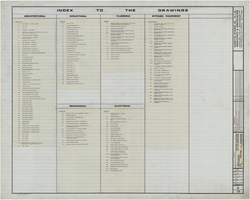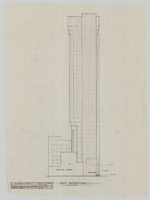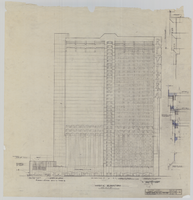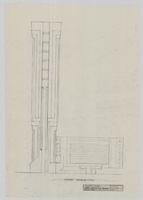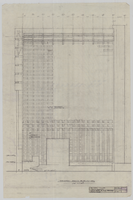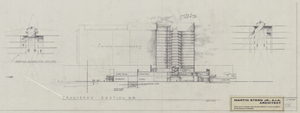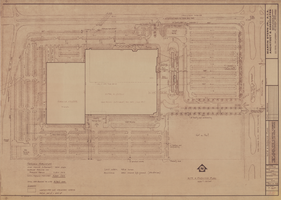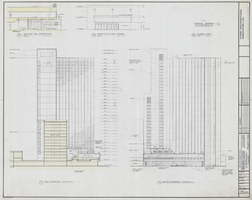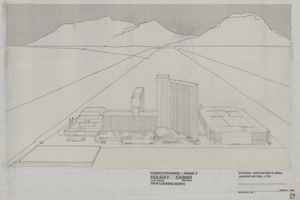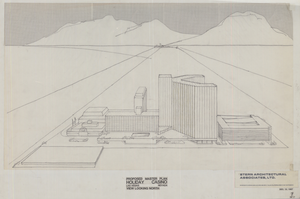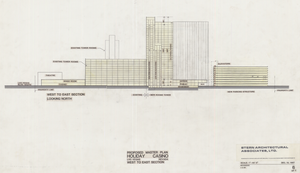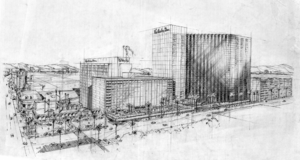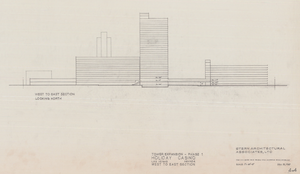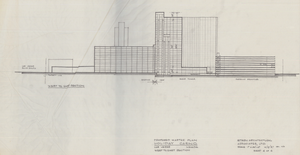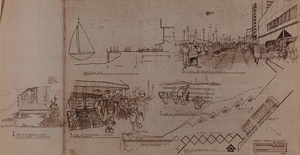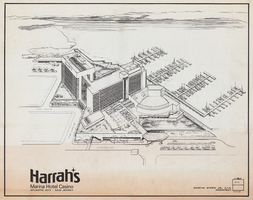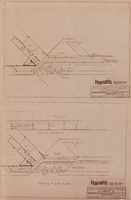Search the Special Collections and Archives Portal
Stern, Martin, 1917-2001
Description
Known for how his design work changed the Las Vegas Skyline, Martin Stern Jr. influenced resort design internationally through his vision of master-planned structurally-integrated casino resort complexes, his fusion of conceptual themes with natural environments, and his enlargement of casino resort scale and complexity. He and his studio, Martin Stern Jr., AIA Architect and Associates, redefined both the casino’s streetscape experience and the project’s visual impact on the skyline. From pencil to plans and from steel beam to towering signs, Stern’s work set the stage for modern design trends—an effect still felt decades later.
Martin Stern Jr. was born on April 9, 1917 in New York and moved to Beverly Hills, California after completing high school. Stern studied architectural engineering at the University of Southern California, and, upon graduating, became a sketch artist for a Hollywood film studio. He worked on various military construction projects before enlisting into the army in 1942 and was promoted to First Lieutenant in the Army Corps of Engineers in 1943. After the war, Stern returned to California and started his own business designing and supervising the construction of apartment buildings.
He was licensed as an architect in California in 1946 and became a member of the American Institute of Architects (AIA) in 1947. Between 1951 and 1953, he served in the army as a reservist First Lieutenant in the 6th Army’s Corps of Engineers, in the Construction and Planning Division, designing master plans and construction programs for army camps throughout America including Camp Irwin and Camp Cook in California. After his discharge, Stern began his own practice in Beverly Hills designing various residential, commercial, and retail projects, notably the Ship’s Coffee Shops. Stern’s designs for the Ship’s Coffee Shops, in the then contemporary Googie-style, were among the more notable built works of Los Angeles’ drive-in culture.
In 1953 Stern designed the low-rise room additions for the Sahara Hotel for Diller Construction Company—his first built work in Las Vegas, Nevada. Then, in 1954, Stern began a long association with Arizona construction contractor and developer Del Webb, who had taken over the construction (and ownership) of the Sahara Hotel. For Stern, it was the beginning of a succession of Sahara Hotel projects. These Sahara projects included the first 14-story high-rise tower in 1959, the later additions of a convention facility in 1967, a 342-room high-rise addition in 1977 and another 625-room addition in 1979. As one of the first to build vertical hotel towers, Stern took the first steps in changing the architectural landscape of Las Vegas from a loose collection of low-slung, sprawling hotels to the booming mega-resort casino hotels seen in Las Vegas today.
Outside of Las Vegas, Stern’s work with Del Webb included the Del Webb Towne Houses, the Kuilima resort and country club in Hawaii, the Sahara at Lake Tahoe, and Webb’s personal residence. In Las Vegas, Stern also designed a new tower for the Sands Hotel in 1964, and a tower for The Mint Hotel in 1968. These projects throughout the 1960s established Stern’s reputation as a hotel architect and, along with towers for the Riviera and Stardust, began to change the look of the Las Vegas skyline. Webb remained Stern’s biggest single client until Stern began designing for the next generation of resort developers—Bill Harrah and Kirk Kerkorian.
In 1969, Stern, along with Kerkorian, took a pivotal step in changing the architectural landscape of Las Vegas with the design and construction of The International Hotel. The design of The International Hotel, perhaps inspired by the challenges of expanding and remodeling the Sahara, demonstrated Stern’s skill in master planning, which he had gained from his experiences in the Army Corp. of Engineers. This new hotel was the first Las Vegas resort to plan the hotel, guest amenities, casino, convention, restaurant, and retail spaces as a single, cohesive design—giving birth to the architectural genre of structurally integrated casino resort complexes, or mega-resorts.
Stern’s design for Kerkorian’s The International Hotel also gave Las Vegas a new architectural form, the three-wing tower plan, and, by being promoted as the largest of its time at 1500 rooms, pushed Las Vegas architecture into the hyperbolic scales of the world’s largest or most expensive. Joel Bergman, Stern’s project architect for the MGM Grand Hotel, later adapted the three-wing plan for a number of Las Vegas properties with Steve Wynn: first, with the Mirage Hotel and Casino in 1989 and then most notably, or expensively, with the Bellagio Hotel and Casino in 1998.
In 1970 Kirk Kerkorian sold The International Hotel to Hilton Hotels Corporation and rebranded it as Las Vegas Hilton (currently branded as Westgate Las Vegas), and began work with Stern on another casino resort complex—the MGM Grand Hotel. Stern’s design for Kerkorian’s MGM Grand Hotel (now Bally’s Las Vegas) opened in 1973. This design, themed after movies from Kerkorian’s MGM Film Studios, pushed the scale of mega-resorts even further—2,084 rooms—reclaiming the title of world’s largest hotel from The Las Vegas Hilton.
Together, Stern and Kerkorian established, through The International Hotel and MGM Grand Hotel, the structurally integrated casino resort complex, the architectural form of the three-wing plan, the hyperbolic scale of design, and also advanced the themed aesthetics that came to define architectural landscape of the Las Vegas Strip. Many of these elements were to be combined most elegantly in his proposed 1975 design for the Xanadu Hotel Casino.
Stern was also responsible for the export of the Las Vegas hotel and casino resorts to other resort centers. His association with Bill Harrah made him the most prolific architect in Atlantic City, New Jersey and in Reno and Lake Tahoe, Nevada where his Las Vegas forms were often repeated in scaled-down versions such as the MGM Grand in Reno. However, Stern did not simply transplant Las Vegas hotels to other cities; his designs for the Showboat and Playboy and Marina properties in Atlantic City, Harrah's, Sahara, and Harveys at Tahoe, and the Kuilima Hotel and Country Club in Hawaii were distinctive and carefully designed blends of a resort theme with its natural setting. The Atlantic City Showboat design, for example, took the traditional gambling boat motif of the Las Vegas Showboat hotels, and Stern’s unrealized Xanadu project, and rendered it into a modern stylized and streamlined cruise ship design. The marina motif was carried further in the smooth sleek sailing lines of Harrah’s Marina in Atlantic City, New Jersey.
Stern closed his architectural practice in 1996 and donated his collection of the architectural drawings and documents generated to produce his buildings to the University Library at the University of Nevada-Las Vegas (UNLV). When Martin Stern donated his drawings to UNLV, he remarked that, from them, all his buildings could be reconstructed to the last detail. Martin Stern died on July 28, 2001 in Los Angeles, California. Stern's work to transform the Las Vegas skyline left an architectural legacy that continues to influence resort architecture today.
Authority Sources
